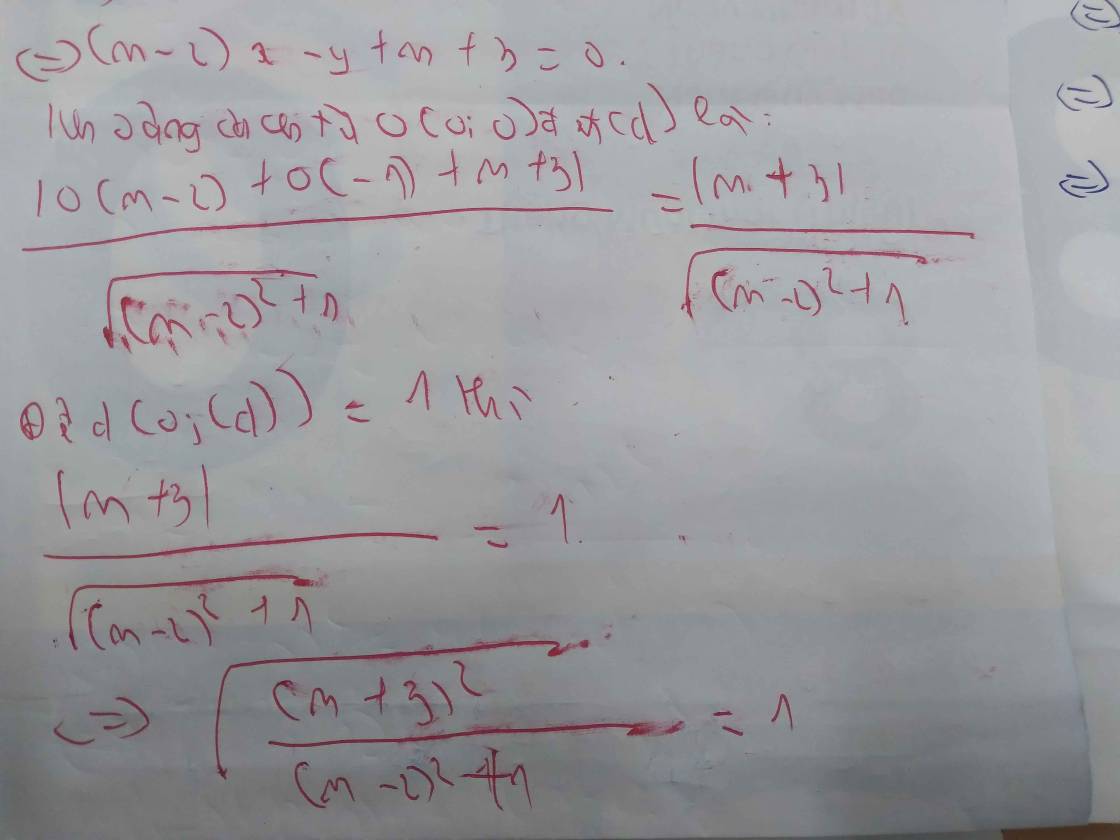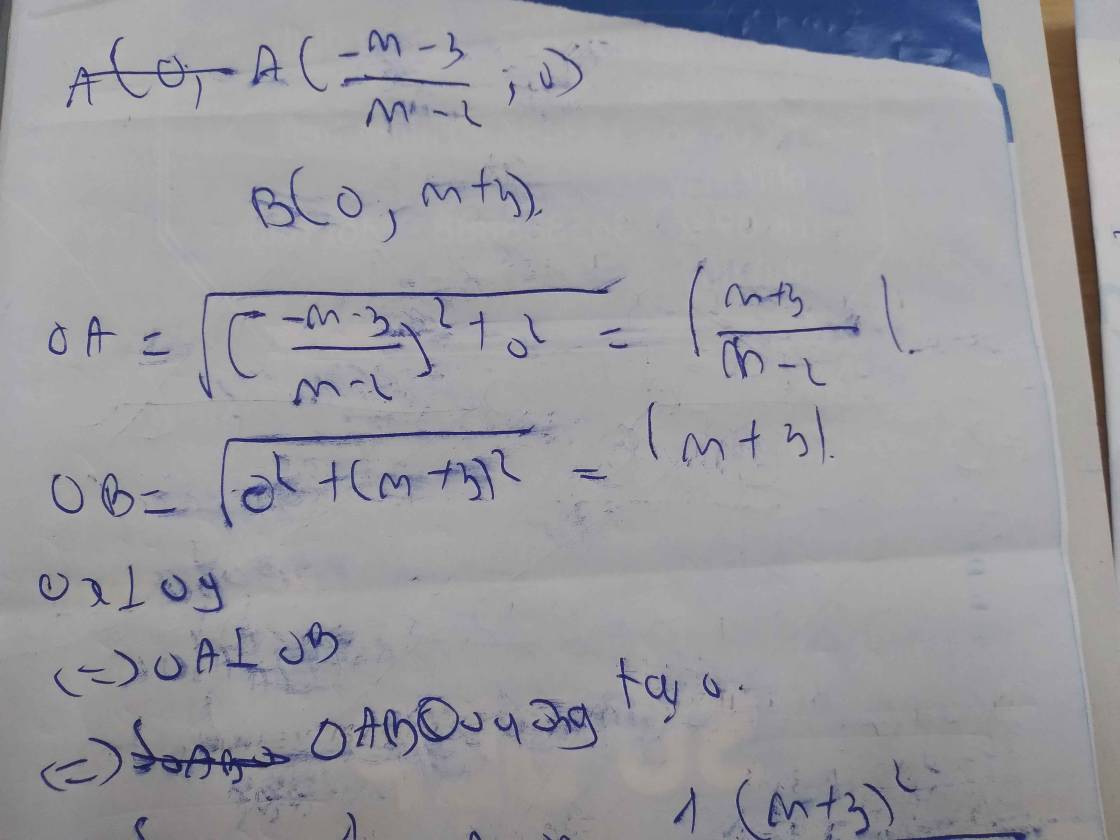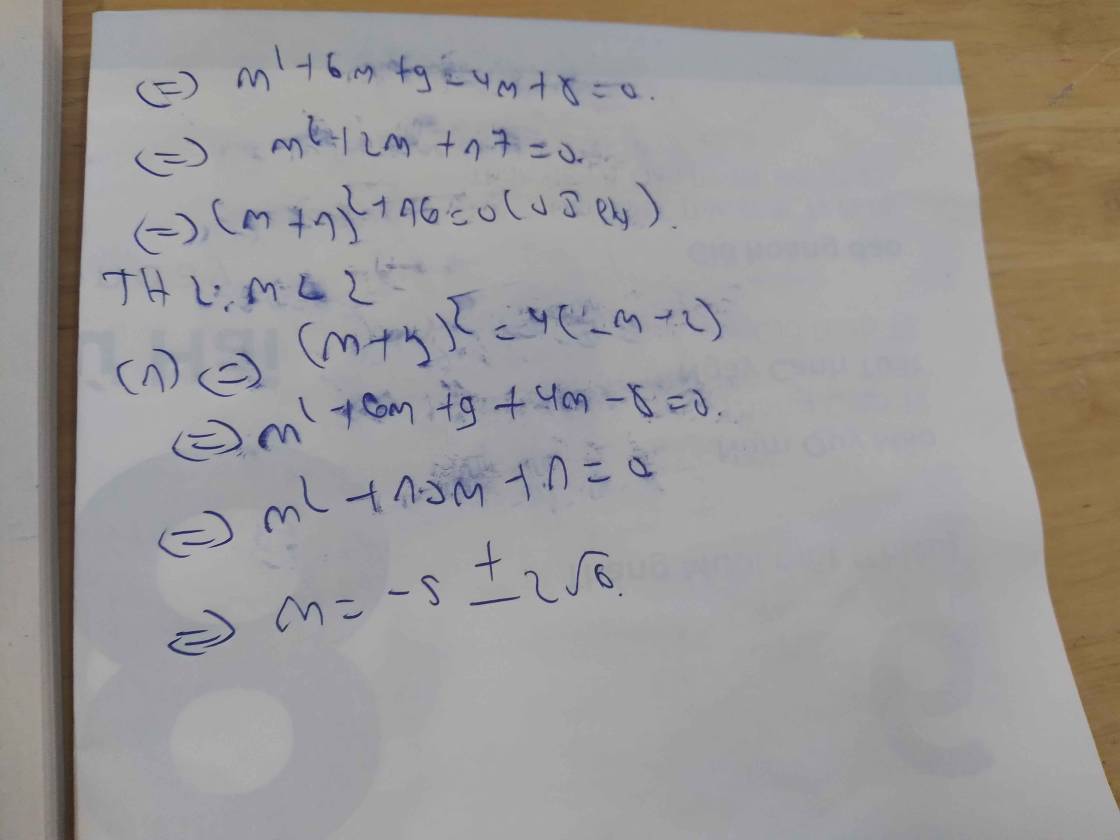Hãy nhập câu hỏi của bạn vào đây, nếu là tài khoản VIP, bạn sẽ được ưu tiên trả lời.

\(a,\) Gọi điểm cố định (d) luôn đi qua là \(A\left(x_0;y_0\right)\)
\(\Leftrightarrow y_0=\left(m-2\right)x_0+2\Leftrightarrow mx_0-2x_0+2-y_0=0\\ \Leftrightarrow\left\{{}\begin{matrix}x_0=0\\2-2x_0-y_0=0\end{matrix}\right.\Leftrightarrow\left\{{}\begin{matrix}x_0=0\\y_0=2\end{matrix}\right.\Leftrightarrow A\left(0;2\right)\)
Vậy \(A\left(0;2\right)\) là điểm cố định mà (d) lun đi qua
\(b,\) PT giao Ox,Oy: \(y=0\Leftrightarrow x=\dfrac{2}{2-m}\Leftrightarrow B\left(\dfrac{2}{2-m};0\right)\Leftrightarrow OB=\dfrac{2}{\left|m-2\right|}\\ x=0\Leftrightarrow y=2\Leftrightarrow C\left(0;2\right)\Leftrightarrow OC=2\)
Gọi H là chân đường cao từ O đến (d) \(\Leftrightarrow OH=1\)
Áp dụng HTL: \(\dfrac{1}{OH^2}=1=\dfrac{1}{OB^2}+\dfrac{1}{OC^2}=\dfrac{\left(m-2\right)^2}{4}+\dfrac{1}{4}\)
\(\Leftrightarrow m^2-4m+4+1=4\\ \Leftrightarrow m^2-4m+1=0\\ \Leftrightarrow\left[{}\begin{matrix}m=2+\sqrt{3}\\m=2-\sqrt{3}\end{matrix}\right.\)
\(c,\) Áp dụng HTL: \(\dfrac{1}{OH^2}=\dfrac{1}{OC^2}+\dfrac{1}{OB^2}=\dfrac{\left(m-2\right)^2}{4}+\dfrac{1}{4}\)
Đặt \(OH^2=t\)
\(\Leftrightarrow\dfrac{1}{t}=\dfrac{m^2-4m+5}{4}\Leftrightarrow t=\dfrac{4}{\left(m-2\right)^2+1}\le\dfrac{4}{0+1}=4\\ \Leftrightarrow OH\le2\\ OH_{max}=2\Leftrightarrow m=2\)

a) \(\left(d\right):y=\left(m-2\right)x+m+3\)
Gọi \(A\left(x_o;y_o\right)\) là điểm cố định mà \(\left(d\right)\) đi qua, nên ta có :
\(y_o=\left(m-2\right)x_o+m+3,\forall m\in R\)
\(\Leftrightarrow y_o=mx_o-2x_o+m+3,\forall m\in R\)
\(\Leftrightarrow mx_o+m+2x_o+y_o-3=0,\forall m\in R\)
\(\Leftrightarrow\left(x_o+1\right)m+\left(2x_o+y_o-3\right)=0,\forall m\in R\)
\(\Leftrightarrow\left\{{}\begin{matrix}x_o+1=0\\2x_o+y_o-3=0\end{matrix}\right.\)
\(\Leftrightarrow\left\{{}\begin{matrix}x_o=-1\\y_o=5\end{matrix}\right.\) \(\Rightarrow A\left(-1;5\right)\)
Vậy Với mọi m, đường thẳng \(\left(d\right)\) luôn đi qua điểm cố định \(A\left(-1;5\right)\)
b) Gọi \(\left\{{}\begin{matrix}\left(d\right)\cap Ox=A\\\left(d\right)\cap Oy=B\end{matrix}\right.\)
Tọa độ điểm \(A\) thỏa mãn
\(\Leftrightarrow\left\{{}\begin{matrix}y=0\\y=\left(m-2\right)x+m+3\end{matrix}\right.\) \(\Leftrightarrow\left\{{}\begin{matrix}x=\dfrac{m+3}{2-m}\\y=0\end{matrix}\right.\)
\(\Rightarrow A\left(\dfrac{m+3}{2-m};0\right)\)
\(\Rightarrow OA=\sqrt[]{\left(\dfrac{m+3}{2-m}\right)^2}=\left|\dfrac{m+3}{2-m}\right|\)
Tọa độ điểm \(B\) thỏa mãn
\(\Leftrightarrow\left\{{}\begin{matrix}y=\left(m-2\right)x+m+3\\x=0\end{matrix}\right.\)
\(\Leftrightarrow\left\{{}\begin{matrix}x=0\\y=m+3\end{matrix}\right.\) \(\Rightarrow B\left(0;m+3\right)\)
\(\Rightarrow OB=\sqrt[]{\left(m+3\right)^2}=\left|m+3\right|\)
\(S_{OAB}=2\Leftrightarrow\dfrac{1}{2}OA.OB=2\)
\(\Leftrightarrow\left|\dfrac{m+3}{2-m}\right|.\left|m+3\right|=4\)
\(\Leftrightarrow\left(m+3\right)^2=4\left|2-m\right|\left(1\right)\)
\(TH1:2-m>0\Leftrightarrow m< 2\)
\(\left(1\right)\Leftrightarrow\left(m+3\right)^2=4\left(2-m\right)\)
\(\Leftrightarrow m^2+6m+9=8-4m\)
\(\Leftrightarrow m^2+10m+1=0\)
\(\Leftrightarrow\left[{}\begin{matrix}m=-5+2\sqrt[]{6}\left(tm\right)\\m=-5-2\sqrt[]{6}\left(tm\right)\end{matrix}\right.\)
\(TH2:2-m< 0\Leftrightarrow m>2\)
\(\left(1\right)\Leftrightarrow\left(m+3\right)^2=4\left(m-2\right)\)
\(\Leftrightarrow m^2+6m+9=4m-8\)
\(\Leftrightarrow m^2+2m+17=0\)
\(\Leftrightarrow\) Phương trình vô nghiệm
Vậy \(\left[{}\begin{matrix}m=-5+2\sqrt[]{6}\\m=-5-2\sqrt[]{6}\end{matrix}\right.\) thỏa mãn đề bài

Bài 2:
a: Phương trình hoành độ giao điểm là:
x-2=2-x
\(\Leftrightarrow2x=4\)
hay x=2
Thay x=2 vào (d1), ta được:
y=2-2=0
Thay x=2 và y=0 vào (d3), ta được:
2(2-m)+1=0
\(\Leftrightarrow4-2m+1=0\)
hay \(m=\dfrac{5}{2}\)






